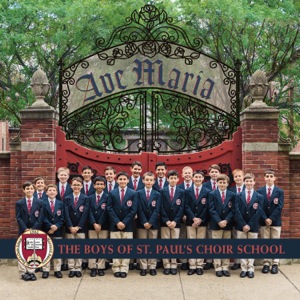
 N THE FEAST of the Nativity of the Blessed Virgin Mary, the St. Paul’s Choir School, Harvard Square, announces the release of its second international recording, Ave Maria. This follows the 2014 CD Christmas in Harvard Square which reached #1 on Billboard Magazine’s Classical Traditional Charts.
N THE FEAST of the Nativity of the Blessed Virgin Mary, the St. Paul’s Choir School, Harvard Square, announces the release of its second international recording, Ave Maria. This follows the 2014 CD Christmas in Harvard Square which reached #1 on Billboard Magazine’s Classical Traditional Charts.
Led by a superlative music staff at St. Paul’s, the CD was directed by Choirmaster, John Robinson and accompanied by organist, Jeremy Bruns. Furthermore, the CD was produced by eleven-time Grammy Award-winner Christopher Alder, and Grammy Award-winner, Brad Michel. The CD is released by De Montfort Music/Sony Classical and its sister label AimHigher Recordings. They are responsible for several #1 Classical CDs including BENEDICTA: Marian Chant from Norcia.
* * Order the CD: Ave Maria • Saint Paul’s Choir School • Harvard Square
* * Order from iTunes: Ave Maria • Saint Paul’s Choir School • Harvard Square
 N ADDITION to singing daily Mass, the St. Paul’s Choir School has sung in venues from Carnegie Hall, Boston Symphony Hall, to Fenway Park. They have enjoyed enormous national publicity having been featured on CBS This Morning, NPR, Good Morning America, Fox & Friends, WGBH, Boston Globe and on their own PBS Special.
N ADDITION to singing daily Mass, the St. Paul’s Choir School has sung in venues from Carnegie Hall, Boston Symphony Hall, to Fenway Park. They have enjoyed enormous national publicity having been featured on CBS This Morning, NPR, Good Morning America, Fox & Friends, WGBH, Boston Globe and on their own PBS Special.
IN THIS TRAILER FOR Ave Maria, you can find out what are each of the boys’ favorite pieces!

 TTRACTING STUDENTS FROM all over America and the world, the St. Paul’s Choir School has transformed countless lives. One need look no further than St. Paul’s current pastor, Fr. William T. Kelly, a graduate of St. Paul’s (formerly known as the Boston Archdiocesan Choir School). In a conversation while he was Pastor of St. Mary’s of the Assumption in Dedham, Massachusetts, he said his calling to the priesthood grew directly out of his life as a student at St. Paul’s. Singing the Mass as a child was an enormous part of his spiritual education and formation—not only musical.
TTRACTING STUDENTS FROM all over America and the world, the St. Paul’s Choir School has transformed countless lives. One need look no further than St. Paul’s current pastor, Fr. William T. Kelly, a graduate of St. Paul’s (formerly known as the Boston Archdiocesan Choir School). In a conversation while he was Pastor of St. Mary’s of the Assumption in Dedham, Massachusetts, he said his calling to the priesthood grew directly out of his life as a student at St. Paul’s. Singing the Mass as a child was an enormous part of his spiritual education and formation—not only musical.
Furthermore, Choirmaster John Robinson speaks quite passionately regarding the impact such music has on the spirit, intellect, and character of young hearts and minds. In doing so, he even evokes the Communion of the Saints:
“When I introduce young minds to the beautiful heritage of Church music, it’s always amazing to see just how much they love the great music we have been given. Music is such a powerful tool for forming young minds, and of course it goes so far emotionally in uniting us with each other, but also with our families on earth and in heaven.
It’s amazing to think that if, say, Palestrina walked into Church during our 11.00 Mass, he would hear his music, and there would be a sense in which we are all joined together by this shared experience, which we’ve been given. You can see the boys growing in maturity and responsibility as the power and clarity of the musical thoughts help shape their minds in love of God and neighbor.
There’s a clear link with their academic development as well, since the concentration required to learn to sing this great music transfers perfectly to study.”
— John Robinson
Regardless of what one eventually does in life, music education is an invaluable discipline that leads to developing many valuable life skills, intellectual, emotional, spiritual, interpersonal, etc. Such education immersed in faith will lead to transformation.
This is true of the boys who enter the St. Paul Choir School. It has been true of generations past under its legendary founder, Theoodore Marier and under former Headmaster, Principal, Organist, and Choirmaster, John Dunn. Now, under John Robinson, the St. Paul Choir School continues on the international stage. But praising God with music is above all. These new recordings afford new opportunities for evangelization, and as such, a new responsibility for the school.
Finally, if you know a talented third or fourth grade boy, you can learn more about Applying to Become a Choirboy where you can see information about admissions, tuition, and opportunities at the Saint Paul’s Choir School.
Soli Deo gloria
